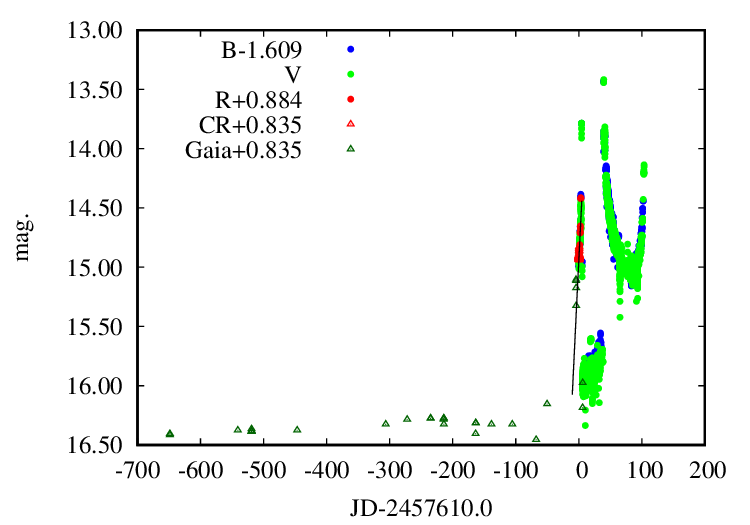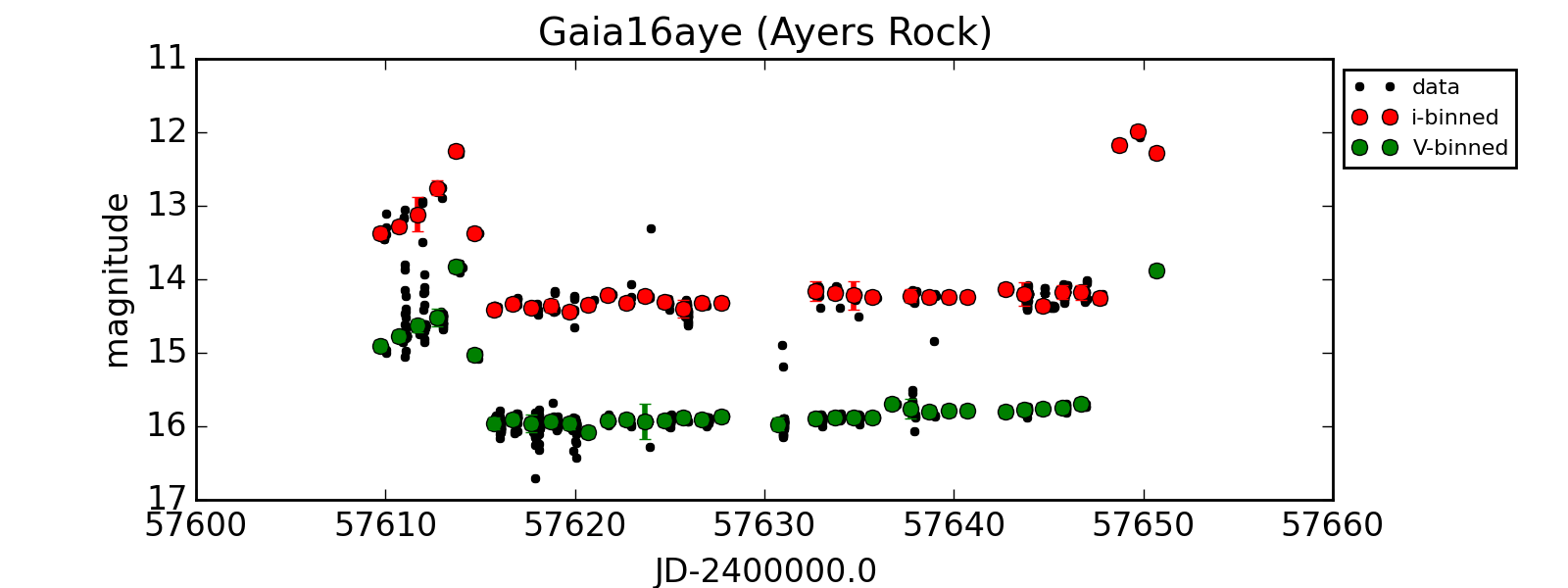› Fora › SEKTIONER I ASTRONOMISK SELSKAB › Sektionen for variable stjerner › Mikrolinse Gaia16aye, Caustic Crossing overstået
- Dette emne har 89 svar og 8 stemmer, og blev senest opdateret for 7 år, 3 måneder siden af nightsky. This post has been viewed 2724 times
-
ForfatterIndlæg
-
20. september 2016 kl. 21:10 #151218
nightskyDeltager- Neutron star
Den 5. aug. kom der en Science Alert fra Gaia, Gaia16aye.
Ayers Rock,dens øgenavn, (19:40:01,13 +30:07:53,4 – J2000) er en stille stjerne som d. 5. aug.
blusede voldsomt op (flare).Gaia Alerts: Gaia16aye
http://gsaweb.ast.cam.ac.uk/alerts/alert/Gaia16aye/Den anden opblusning kom nogle dage senere
http://scan.sai.msu.ru/~kirx/ATel/Gaia16aye/
Spektroskopi peger på en normal K8-M2 stjerne
D. 17. sep kom der en kraftig opblusning igen, mag 12. I båndet. ( Caustic crossing)
http://www.astronomerstelegram.org/?read=9507
Meget tyder på det er en såkaldt mikrolinse effekt og derfor kan vi også forvente en fjerde
opblusning når som helst. Altså nu…Alle opfordres til at lave observationer af denne stjerne, også med lille aperatur. En oplagt
chance for os amatører til at bidrage med noget hard-core fantastisk videnskab.Amatører opfordres også til at lave spektroskopi på stjernen så man kan få mere at vide
om kilden og linsen. Med en mag12-14 tror jeg det bliver meget svært. Min SA kunne sagtens
gøre det, men desværre er feltet alt for fyldt til spalteløs spektroskopi.Bemærk at nøjagtig tidsangivelse på ens optagelser er vigtigt.
Klart vejr nu, tak
Fra Wiki
Binary lensesIf the lens is a binary star with separation of roughly the Einstein radius, the magnification
pattern is more complex than in the single star lenses. In this case, there are typically
three images when the lens is distant from the source, but there is a range of alignments
where two additional images are created. These alignments are known as caustics. At
these alignments, the magnification of the source is formally infinite under the point-source
approximation.Caustic crossings in binary lenses can happen with a wider range of lens geometries than
in a single lens. Like a single lens source caustic, it takes a finite time for the source to
cross the caustic. If this caustic-crossing time t S {displaystyle t_{S}} t_{S} can be
measured, and if the angular radius of the source is known, then again the Einstein angle
can be determined.As in the single lens case when the source magnification is formally infinite, caustic crossing
binary lenses will magnify different portions of the source star at different times. They can
thus probe the structure of the source and its limb darkening.
[TUBE]_0u7DVbw4o4[/TUBE]Nightsky 2016-11-22 17:38:17 20. september 2016 kl. 22:21 #151226
Mogens.BildsøeDeltager- Nova
Hej Lars,
ku være interessant at forsøge, men det kræver jo så at man kan se begivenheden
på sit guide billede- og det kan jeg ikke med mit nuværende kamera. Har nu investeret
i (og fået leveret) et Lodestar X2, som jeg bare ikke kan få til at funger på min
gamle XP maskine. Har arbejdet på sagen siden i går, men har opgivet foreløbig.
Men måske lidt data på Betelgeuse?
Hilsen Mogens B.
20. september 2016 kl. 22:24 #151227
nightskyDeltager- Neutron star
Denne er netop kommet
AAVSO Alert Notice 552
September 20, 2016
Gaia16aye microlensing event monitoring urgently
requestedDr. Kirill Sokolovsky (National Observatory of Athens and
Sternberg Astronomical Institute, Moscow State University), has requested AAVSO
assistance in monitoring the ongoing microlensing event Gaia16aye beginning
immediately to catch transient behavior occurring now and continuing through
the end of October (or until further notice).Dr. Sokolovsky writes: “Gaia16aye was first
identified as an unusual variable object by Gaia on 2016 August 5 (V. Bakis et
al., ATel #9376, http://www.astronomerstelegram.org/?read=9376)
and it was later realized that its achromatic light variations are consistent
with being caused by microlensing of a distant M-type giant star by a binary
star system (possibly consisting of main sequence dwarfs) crossing the line of
sight. The complex geometry of the lens causes multiple brightness peaks
corresponding to caustic crossings. According to preliminary modeling, the
object’s variability was noticed during decline after the first caustic
crossing. The second brightness peak was observed on August 13 and the third
peak on September 19. The source is expected to decline quickly in next days
from its current magnitude V~14 to reach the plateau around V~16 between the
caustics, in order to start rising again to cross the caustic in one or couple
of weeks (L. Wyrzykowski et al., ATel #9507, http://www.astronomerstelegram.org/?read=9507).A well-sampled lightcurve of the microlensing event,
especially during the caustic crossing, is needed to constrain geometry and
some physical parameters of the lens and the lensed star.“CCD observations of Gaia16aye using any subset of
B, V, Rc, Ic, g, r, i filters are requested starting immediately and continuing
for about four weeks (until the decline from the expected next caustic
crossing). If the object is at its bright state around V~14, time series
observations are needed. If the object is found at the plateau level around
V~16, one-two observations per night are sufficient. Unfiltered CCD
observations are also useful if photometric measurements are collected during
multiple nights (otherwise it would be difficult to match the unfiltered
measurements to the data collected by other observers).“Observers are asked to… [reduce their data in
their usual way using] UCAC4 601-089811 as the comparison star and submit
observations to the AAVSO International Database using the standard
procedure.” UCAC4 601-089811 is the 145 comparison star in the AAVSO
sequence for Gaia16aye.Observers are also requested to upload their calibrated
(dark and flat-field corrected) images to the anonymous FTP server ftp://scan.sai.msu.ru/uploads/ for
semi-automated processing with the Cambridge Photometry Calibration Server
pipeline.”Coordinates (2000.0): R.A. 19 40 01.13 Dec. +30 07 53.4
Charts with a comparison star sequence for Gaia16aye may
be created using the AAVSO Variable Star Plotter (VSP, https://www.aavso.org/vsp).Creating an ‘e’ or ‘f’ scale chart is recommended.
Please submit observations to the AAVSO International
Database using the name Gaia16aye (there are no spaces within the name).This campaign is being followed on the AAVSO Observing
Campaigns webpage (https://www.aavso.org/observing-campaigns).
A thread has been created on the Campaigns and Observation Reports forum at (https://www.aavso.org/content/gaia16aye-microlensing-campaign).20. september 2016 kl. 23:45 #151232
Lars MalmgrenDeltager- Super Nova
Spændende!!
21. september 2016 kl. 00:48 #151234
Frank LarsenModerator- Super Nova
Argh, nede på udstyr og regnbyer
 21. september 2016 kl. 01:39 #151235
21. september 2016 kl. 01:39 #151235
Lars MalmgrenDeltager- Super Nova
Nightsky wrote: the ongoing microlensing event Gaia16aye beginning
immediately to catch transient behavior occurring now and continuing through
the end of October (or until further notice).Der er tid
 21. september 2016 kl. 22:29 #151257
21. september 2016 kl. 22:29 #151257
nightskyDeltager- Neutron star
Juhu, så er jeg i gang med at tage en mindre tidsserie i V.
Håber der bliver mere klart vejr…
22. september 2016 kl. 00:23 #151260
Lars MalmgrenDeltager- Super Nova
Hvad ligger dens mag. på lige nu?
Lars Malmgren 2016-09-22 00:24:30 22. september 2016 kl. 00:39 #151261
nightskyDeltager- Neutron star
Super spændende resultater
Jeg finder at Gaia16aye er på lyst stadie lige nu, noget over plateau niveauet. Altså skal der
laves tidsserie optagelser, da der er en ”Caustic crossing” på vej.Ved en v-mag 14,18 ser vi altså selve mikrolinse effekten på min optagelse. Så fik jeg også
en mikrolinse begivenhed krydset af på min ønskeliste. Skønt..
Skønt..Er mega spændt på hvordan data sidenhen kommer til at passe ind i billedet.
T (JD) Gaia16aye Ref Chk star
2457653,379 14,18 14,479 14,043I morgen skal der kalibreres mod UCAC4 601-089811

Nightsky 2016-09-22 23:34:30 22. september 2016 kl. 23:33 #151313
nightskyDeltager- Neutron star
Hejsa
Tidligt på aftenen d. 22. sep. fik jeg en kort session med en lille TOA. Ikke det bedste til så
fyldt et felt og det kneb med at få et ordenligt SNR.Lyset fra Gaia16aye observeres stadig kraftigere end normalt, fordi objekter (her binært par)
kredser foran stjernen og dermed laver en mikrolinse effekt der forstærker lyset i bl.a.
V med ca. 2 mag.D.v.s. at Gaia16aye er i “bright state” og vi afventer den fjerde “caustic crossing”
Gaia16aye målinger
2016-09-22T19:34:33 UT V 14,275
2016-09-22T19:45:40 UT Ic 12,547

Nightsky 2016-09-22 23:48:37 23. september 2016 kl. 14:26 #151334
nightskyDeltager- Neutron star
Et telegram bekræfter mine observationer fra i går.
http://www.astronomerstelegram.org/?read=9533
Mere spændende her, brug evt. google translate
http://www.meteoweb.eu/2016/09/astronomia-brillante-evento-di-microlensing-nel-mirino-di-gaia/750917/ 24. september 2016 kl. 02:28 #151384
24. september 2016 kl. 02:28 #151384
jens.jacobsenDeltager- Neutron star
En hurtig reduktion af en optagelse giver en lysstyrke på -0.145 i forhold til UCAC4 stjernen, nr 145 på fotometrilisten. Mag ligger altså stadig på V= 14.33
mvh
Jens24. september 2016 kl. 14:04 #151412
nightskyDeltager- Neutron star
Fint i tråd med målingerne Jens som viser den falder måske 0,1 i magnitude om dagen.
The expected behaviour of such lensing system is that the source will
decline quickly in next
days to reach the plateau between two caustics,
in order to start rising again to cross the
caustic again in one or
couple of weeks. The source will again reach about I=12 mag for about
a
day and then will sharply decline and the event will be over forever.Man har som amatør her en chance for at være med helt i front med uhyre simpelt udstyr.
Korrekt kalibrering af sine billedere og styr på tiden. Det er det hele.En google søgning viser:
Et par events før som nok var binær mikrolinsning
EROS BLG-2000-5
MACHO 99-BLG-47Så er der OGLE-2009-BLG-020 var den første som kunne følges op med observationer fra
jorden og dermed den første som kunne verificeres med doppler observationer.OGLE-2009-BLG-020 er et ∼1,1M⊙ binært system som passerede synslinjen mellem jorden
og en rød gigant stjerne.25. september 2016 kl. 00:10 #151452
nightskyDeltager- Neutron star
V og Ic målinger her til aften, stadig i bright state.
2016-09-24 19:30:17 UT V 14,443
2016-09-24 19:43:43 UT Ic 12,685Dagens Gaia16aye foto
 25. september 2016 kl. 23:28 #151511
25. september 2016 kl. 23:28 #151511
nightskyDeltager- Neutron star
Er voldsomt generet af drivende skyer.
Finder Gaia16aye på ca. 14,5 v mag. her kl. 23.00
Så stadig ikke nogen opblusning, medmindre det er sket siden i går aftes.
Nightsky 2016-09-25 23:28:44 -
ForfatterIndlæg
- Emnet 'Mikrolinse Gaia16aye, Caustic Crossing overstået' er lukket for nye svar.